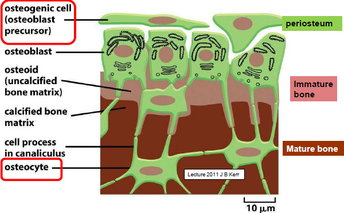Lecture Details[]
Jeff Kerr; Week 1 MED1022; Anatomy
Lecture Content[]
Bone can begin development directly from mesenchymal tissue or indirectly from cartilage which is replaced by bone/matrix. Bone is living tissue with cells and a hard, crystalline matrix. It normally repairs itself if damaged, and bone tissue is labile and is naturally absorbed and replaced. Epiphyses are on the two ends of bones with the diaphysis at the centre. Periosteum forms the outer lining and endosteum the inner lining. Cancellous bone is in the centre of the bone with the periosteum/endosteum made of compact bone. Articular cartilage does not have periosteum. Periosteum contains fibroblasts.
Bone is a dense inflexible connective tissue where the matrix is hard from deposition of calcium phosphate and other minerals. Hardening is achieved by mineralisation or calcification. Bone is highly vascular, metabolically very active, continually reabsorbed and continuously deposited. By weight it is 23% collagen and proteoglycans and 65% inorganic part.

Bone matrix provides support and strength through hardness, storage for calciuma and phosphorous, collagen is encrusted with CaPO4. Non-collagen proteins can assist with bone mineralisation. Without mineral bone is rubbery, without collagen bone shatters. Immature bone is not organised, mature bone is arranged into cylinders called osteons or Haversian systems. They have a fully mineralised/calcified matrix. Osteoblasts produce bone matrix and control subsequent mineralisation. The matrix surrounds cells which become osteocytes in the mature bone. Osteocytes are the most mature cell of the bone lineage, cytoplasm extends into micro-crevices, the canaliculi. They maintain the bone matrix and remain alive for years. In a bone scan, dark grey cells have less mineralisation as they are younger osteons.
Osteoblast lineage is from osteoproogenitor cells (bone stem cells, persist for life) in the periosteum and endosteum. Osteopetrosis is excessive bone deposition (increased bone mass/anaemia; osteoporosis is loss of bone mass (fragility/fractures). Osteoclasts excavate tunnels in bones where new osteoblasts are deposited. They are monolayer, epithelial-like cells which produce osteoid (non-mineralised bone matrix), initiate and control subsequent mineralisation of the osteoid. In cancellous bone, lamellae form planes and struts. In compact bone there are cylinders of concentric bone lamellae.
Osteoclasts are bone eating cells, derived from monocytes in the bone marrow. They fuse into large multinucleated cells and dissolve the mineral with acid and degrade the organics with enzymes.
Volkmann's canals are vascular channels linking osteons. Lacunae are spaces for osteocytes. Osteons may branch and are align in the direction of forces applied to the bone. Maximum diameter for an osteon is 200um. Old osteons may be lain over by new ones.
The advantages of cancellous bone are that it allows a home for bone marrow, is lightweight but stills strong. Bone health is influenced by adequate supply of substrates and mineralisation process, hormones especially estrogen are important postmenopausally.